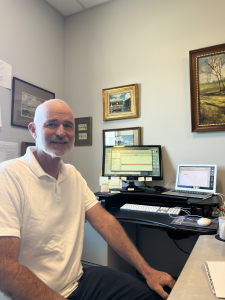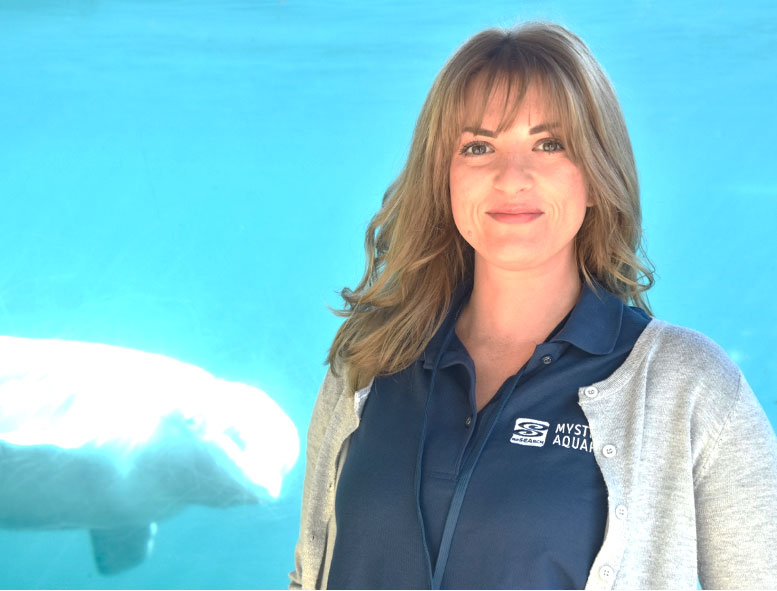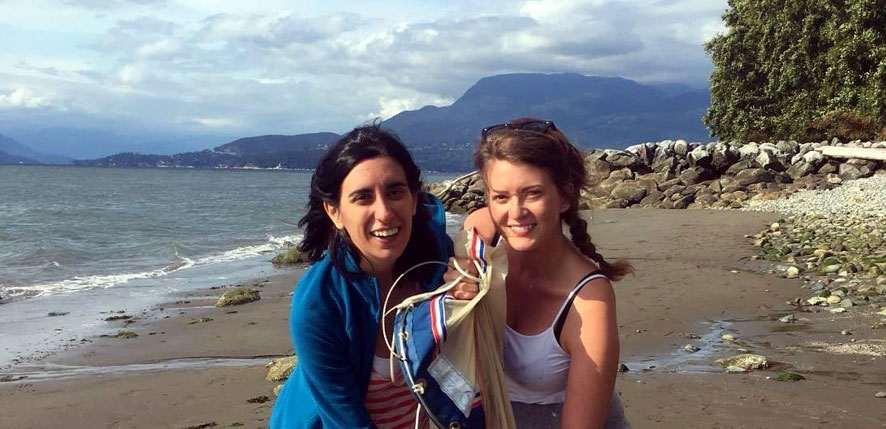
By Mengyang Zhou
George McManus is retiring on February 1, 2024, after 28 years at the university. Graduate student Mengyang Zhou sat down with him to capture George’s reflection on his amazing career and find out what he plans to do next.
Mengyang: How did you decide to pursue a career in academia?
George: I was interested in environmental science and had a degree in biology. So I thought I might want to be an environmental lawyer, actually. Then I went to Stony Brook University to get a master’s degree in marine science before going to law school. But when I got there, I really liked science much more, and I said I don’t want to be a lawyer. So I stayed at Stony Brook and got my PhD in 1986. Then I had a postdoc in upstate New York at the Cary Institute, and another postdoc at the University of Maryland. Then I got a faculty job at the University of South Alabama. In 1995, I got the job at UConn, and I’ve been here since then. A lot of changes in that period of time. When I got here, I think there were maybe a dozen of faculty, and there was only one woman. They just started the undergraduate major, which was called Coastal Studies at that time, and they had the graduate program here. And when I started out, I was teaching two days a week at the Stamford campus. But then in 1998, I got transferred here to the Avery Point campus so I had my lab and my teaching here. And I’ve been just here ever since.
Mengyang: What are the changes that you saw in our department over the years?
George: One big change is that the faculty is much bigger now. Also, the undergraduate major has really grown. Now we have around 100 students in this major. A big change is this building. When I got here, there were two kind-of broken down buildings with not very good facilities, and they were crumbling. This building was started in 2001, I think. And it really made a big difference in the facility and labs. I used to be in another building that was taken down, and I could look out across here and see this new building going up. Sometimes I walked over here and stood here when it was just concrete and nothing else, so I knew I was going to be in this office. The department has also grown a lot in research funding. One thing that really hasn’t changed is that it’s still a relatively small department. And people still collaborate a lot with each other. When departments get big, they break down into different groups, and all of a sudden, you’re just a smaller part of the bigger group. But here it’s still small enough that people, from geochemistry or physical oceanography or biology, still talk to each other. The Avery Point campus itself has also changed a lot. The facilities have gotten a lot better. I think we’ve gotten higher quality students here.
Mengyang: Can you talk about how your research and the field changed over the years?
George: I am always interested in plankton. For my PhD, I studied little tiny flagellates that eat bacteria. And I was always interested in the food chain, the protozoa and how they fit into the food chain. The food chain in the ocean can be very long because it starts with tiny things and takes many steps before you get something big like a fish. I also did a master’s degree about copepods and copepod processing of PCBs (polychlorinated biphenyls), which is an environmental contaminant. I did a postdoc in upstate New York. It was a freshwater environment. I studied a little lake for a whole year, measuring who eats different kinds of bacteria and how the food chain was set up. And then when I got down to Maryland, I got interested a little bit in phytoplankton, because I was interested in using different phytoplankton pigments to identify which kinds of algae were there, and who was grazing on them by changes in the different pigments. Then I got interested in slightly bigger things like ciliates and other kinds of grazers. I continued that work when I went to Alabama.
One thing that I discovered in graduate school, but it was a side thing, not part of my dissertation, was that there were some ciliates that eat phytoplankton and they digest everything, but they keep the chloroplast, and the chloroplasts can still be functional. So they can photosynthesize based on the food that they eat. They’re called mixotrophs, because they’re eating but also photosynthesizing. And that was something I thought was really fascinating. It was an experience of discovery in my life. I remember looking in the microscope and putting on the fluorescent light and seeing all these chloroplasts inside of ciliates and I just ran out of the room to try to find somebody to show this to. But I didn’t really get back to that until I went on a sabbatical, when I was at UConn in 2002. And I was in Ireland, studying this little mixotrophic ciliate that lives in tide pools. And I started, also at the same time, collaborating with a person at Smith College, Dr. Laura Katz. She’s a molecular biologist. So I would pick these ciliates, and then she would sequence their DNA. And one of the things we found out is we could sequence the chloroplast and find out what kinds of algae they were eating. Huan Zhang and Senjie Lin also helped me with this. It turns out, they’re eating macro algae. They actually eat the spores from seaweeds. We could tell that from the genome of the chloroplast. And from that point in the early 2000s, I really kind of focused on using molecular methods to document diversity of protozoa, especially ciliates in the natural environment. I still always had an interest in the food chain, and I did some work in Brazil with Hans Dam (also a faculty member in our department) on the tropical upwelling system and how the food chain is structured there. But mostly, a big part of what I have been doing is cultivating the organisms. We’ve had a long time series out here at the dock on campus, collecting ciliates, trying to culture them and identify them. Then we barcode them, in other words, we take a piece of the DNA that we sequence, and that lets us identify them. If we get the same thing later, we can verify from the DNA. So I think my lab developed kind of a specialty in being able to cultivate these organisms because they’re very, very fastidious, and hard to cultivate. And then especially with collaborations with my colleague at Smith College, being able to sequence them and eventually we got to where we could sequence the whole genome or the whole transcriptome. When we first did that, the Moore Foundation funded a study of eukaryotic plankton transcriptomes. Anybody who had anything in culture that they wanted to sequence, the foundation would do it. We had the ciliate that I talked about, that grows in the tide pools and eats seaweed. We had them in culture, but to collect enough RNA, I would have to filter quite a bit and they don’t like to be caught on a filter. They kind of blow up on the filter and they don’t like to be centrifuged. So I picked individuals and I had to pick 22,000 of them. I picked maybe a couple of 1000 every day for two weeks. Within a couple of years, now you can just pick one and get the whole transcriptome from the methods people have now. So even in the short time of my career, things have changed so dramatically. We have a lot of new tools now to look at the genes and the gene expression in these organisms, not only in culture, but also we’ve been on cruises on the shelf here and collected things and sequence them from that.
Mengyang: What are the things you are going to miss after retirement?
George: I’ll miss the people. One of the things that I really hated about COVID was that everybody was working remotely. And that just does not suit me. From the very beginning, the university let people back into their labs if they had things like cultures to maintain, and I was basically coming in every week. But there weren’t too many other people here. I missed the people because of all the years before and even now since COVID is pretty much over. You see people and interact with them. I will still come in for the first year or two, and go to seminars and talk to people. But I think I won’t be active in the research part of it. I may go to some meetings, but I’m not going to keep any more cultures. I’m part of the SCOR working group. SCOR is the Scientific Committee on Oceanic Research. It’s an international organization. The NSF (National Science Foundation) funds these working groups on specific topics. The one that I’m involved in, with another year and a half to go, is about mixotrophs, organisms that both feed and also photosynthesize. I’ll have a meeting in Brazil next year, and maybe another meeting in Asia after that. So I’ll still be active intellectually, but probably not be doing research directly.
Mengyang: Do you have some final words to reflect on your academic career?
George: I think I’ve been very lucky that every day that I got up, I drove to work and I was happy. I always look forward to what I am going to do today. And it’s a tremendous privilege to have that. And kind of to earn your keep, you teach and you have graduate students and so forth. And that’s also fun. I love doing that. I don’t know if in the future, the structure will be quite the same. There’s more of a movement towards having teaching faculty and then research faculty. I’m not sure if the tenure system is going to stay in there. I hope it does. I hope that young people still have the same opportunities I had. It’s been a really great career and I wouldn’t change anything about it. I really enjoyed it.


